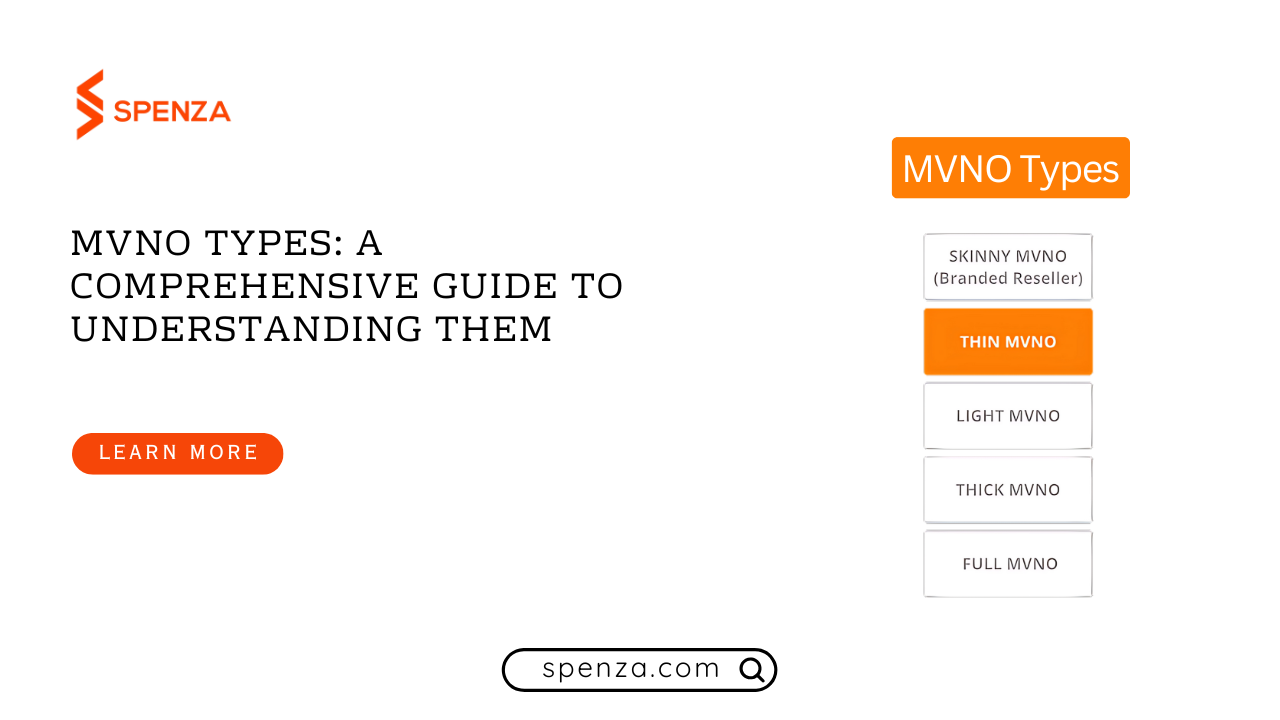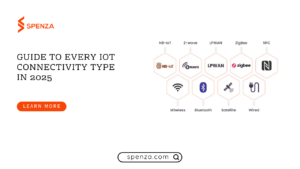With the current world being dominated by mobile connectivity for both voice services and data-driven applications, businesses and consumers rely heavily on mobile connectivity. With new technologies, the Mobile Virtual Network Operator (MVNO) market is slowly growing and presenting several possibilities for mobile networks to be launched and distinguished as separate mobile brands. In this blog post, we’ll dive into the world of Mobile Virtual Network Operators (MVNOs), explore the different MVNO types, and show you how Spenza’s MVNO solution can revolutionize your business. By the end of this blog, you will be able to understand different MVNO operational models and how to select the appropriate type for your organization.

What Is a Mobile Virtual Network Operator (MVNO)?
To understand what different types of Mobile Brands / MVNOs there are you must first understand what an MVNO is. A Mobile Virtual Network Operator (MVNO) is a company that provides mobile services—voice, messaging, and data—to end users but does not own the underlying radio or spectrum infrastructure. Instead, these operators lease access to network resources from existing Mobile Network Operators (MNOs) or via intermediary service providers, such as Mobile Virtual Network Enablers (MVNEs) or Mobile Virtual Network Aggregators (MVNAs). This structure lets MVNOs rapidly enter markets, present new mobile offerings, and target niche segments without the massive capital expenditure that MNOs typically face.
Key Benefits of Operating as an MVNO
- Lower Barriers to Entry:
By leveraging an existing MNO’s infrastructure, an MVNO can focus on developing unique product offerings and branding strategies rather than building and maintaining costly network equipment. - Rapid Deployment:
MVNOs can go to market faster because they do not need to construct or maintain the underlying radio network. - Flexibility in Targeting:
Many MVNO types carve out specialized niches, such as discounted international calling, IoT connectivity, or value-added services for specific consumer segments. - Innovation:
With the arrival of 5G, eSIM technology, and IoT, the MVNO space continues to offer significant opportunities for innovation, allowing companies to test new ideas quickly.
In essence, MVNOs fill the gap for customers who desire unique, niche, or flexible service plans beyond what the mainstream MNOs typically offer. Now, let’s dive deeper into the different MVNO types—commonly known as Branded (Skinny), Thin, Light, Thick, and Full MVNO.
What Are the Different Types of Mobile Brands / MVNOs?
The MVNO types differ in terms of how much of the operational and technical processes they control versus what is handled by the host MNO. This classification helps potential operators figure out their scope of responsibility, level of required investment, and regulatory obligations. Most commonly, we categorize MVNOs into five main types:
Each MVNO type brings unique advantages and challenges, influencing how quickly an operator can enter the market, the investment required, and the range of potential offerings and customizations.
Branded Reseller (Skinny MVNO)
A Branded Reseller, also known as a Skinny MVNO, represents the most lightweight MVNO model. In this arrangement, the MVNO rebrands and resells existing mobile services that are almost entirely managed and controlled by the host Mobile Network Operator (MNO) or a Mobile Virtual Network Enabler (MVNE). Responsibilities such as billing, rating, customer support infrastructure, and systems integration are primarily handled by the network provider, enabling a Branded Reseller to launch quickly and with minimal effort. Typically, no license is required to operate as a Branded Reseller (Skinny MVNO).
Key Features:
- Lowest Barriers to Entry: Branded (Skinny) MVNOs primarily rely on the host MNO for operational processes, significantly lowering startup costs.
- Fastest Time to Market: Because the infrastructure is fully managed by the partner MNO or MVNE, a Skinny MVNO can go live with minimal lag.
- Limited Customization: Branded Resellers are limited by the existing tariffs and features of the host network. Essentially, if the MNO does not provide a specific data bundle or specialized function, the Skinny MVNO cannot include it in its portfolio.
Use Cases:
- Retail Chains: Large retail chains, such as supermarkets, can launch a Branded Reseller MVNO to offer mobile services to their loyal customers at competitive rates, enhancing customer retention and brand loyalty.
- Established Brands Expanding Reach: Businesses looking to quickly enter the telecom market can do so with minimal investment by becoming a Branded (Skinny) MVNO, leveraging this model to broaden their market presence.
Notable examples of Branded Resellers include Walmart Family Mobile and ALDI Mobile. These companies capitalize on their strong brand recognition to deliver mobile services to their extensive customer bases, seamlessly integrating telecom offerings into their existing ecosystems.
Thin MVNO
Thin MVNOs, also known as Service Provider MVNOs, share many similarities with Branded (Skinny) MVNOs but generally take on slightly more control over customer relationships and service offerings. For example, while the core network infrastructure remains under the management of the MNO, a Thin MVNO might oversee its customer service operations or have greater flexibility in creating customized bundles. Like Branded MVNOs, Thin MVNOs typically do not require a license to operate.
Key Features:
- Slightly More Control: Thin MVNOs may handle billing and customer service, but they rely wholly on the MNO’s (or MVNE’s) network systems for tasks such as rating, SIM provisioning, and other technical operations.
- Variable Branding Options: Because they have more control than Branded Resellers, these MVNOs can tweak pricing or create specialized promotional campaigns to stand out.
- Low CAPEX/OPEX: Thin MVNO operations still involve significantly lower costs than deeper, more infrastructure-heavy MVNO types.
Use Cases:
- Market-Savvy Startups: A small technology startup that wants to launch its phone service but does not want to deal with the complexities of building a billing solution from scratch might choose a Thin MVNO approach.
- Specialized Services: Thin MVNOs are popular among those focusing on unique segments, like diaspora communities who need cost-friendly international calling rates.
Light MVNO
Light MVNOs, also known as Enhanced Service Providers or mid-tier MVNOs, take on a greater share of business and operational processes compared to Thin MVNOs. This includes managing certain aspects of the OSS (Operations Support System) and BSS (Business Support System). However, they typically do not own significant network infrastructure. Instead, Light MVNOs connect to the host MNO’s core network while maintaining direct control over billing systems, branding, and marketing strategies.
Key Features:
- Greater Flexibility: Light MVNOs have a higher degree of flexibility in defining rate plans, bundles, and value-added services.
- Independent OSS/BSS: The Light MVNO often manages its own customer care, billing, subscription management platforms, and other technical layers that shape the user experience.
- Mid-Level Control: While they rely on the host for core network elements like the radio network and subscriber registry, Light MVNOs can craft their branding strategies, define marketing campaigns, and design unique user experiences.
Use Cases:
- Companies Seeking Differentiation: A Light MVNO can effectively incorporate advanced features (such as loyalty programs or data rollover) that may not be offered by MNOs, helping them stand out.
- Niche Segment Operators: These might include operators focusing on senior citizens, students, or IoT devices, leveraging specialized billing, data usage analytics, or subscription models
Thick MVNO
A Thick MVNO or enhanced service provider MVNO expands on the Light MVNO model by incorporating or maintaining partial Core Network components, such as a GGSN, Home Subscriber Server, or specific data gateways. By operating certain elements of the MNO’s network architecture, Thick MVNOs can offer advanced features like custom data routing, specialized data analytics, or zero-rated applications. However, because they manage partial network infrastructure, Thick MVNOs often require additional licenses, which vary based on the country and its regulatory framework.
Key Features:
- Infrastructure Ownership: While not a Full MVNO, a Thick MVNO might negotiate wholesale agreements with MNOs or MVNAs and run certain core network aspects in-house.
- Better Offerings: By owning some network control points, Thick MVNOs have the freedom to create advanced value-added services, such as specialized roaming solutions or tailored data usage rules
Use Cases:
- Operators Targeting Technical Differentiation: Thick MVNOs might build unique data/information services for customers, free social media traffic, or premium data usage analytics, aspects that require deeper control of the network’s core.
- Businesses with More Resources: To run a thick MVNO operation, an entity needs bigger investments and stronger technical expertise, making it more suitable for established companies expanding into telecom.
Full MVNO
A Full MVNO is the most independent and sophisticated type of MVNO. While it does not have access to the radio spectrum (which remains under the control of the MNO), a Full MVNO typically owns or manages all critical core network elements, including the Home Location Register (HLR), Home Subscriber Server (HSS), Gateway GPRS Support Node (GGSN), billing and charging engines, and SIM provisioning systems. This level of control provides Full MVNOs with maximum flexibility in designing, packaging, and delivering mobile services.
Key Features
- Full Infrastructure Control: By owning most core network components, Full MVNOs can implement advanced features, customize call flows, manage data usage, and control SIM card issuance.
- Brand Differentiation: Full MVNOs have the ability to fully customize the user experience, including call routing and data management, allowing for greater brand differentiation.
- Larger Investments and More Complexity: As they manage the core network (excluding physical radio towers), Full MVNOs require significant upfront capital, a larger workforce, and advanced technical expertise.
Use Cases
- Established Operators: Telecom companies that are well-versed in network operations might choose to launch a Full MVNO to specifically reach separate demographics or expand internationally.
- Enterprises with Complex Needs: Often, businesses that want total autonomy over data flows (such as high-security or specialized IoT projects) might operate as a Full MVNO.
Conclusion
MVNO models range from Branded Resellers (quick market entry, low investment) to Full MVNOs (complete infrastructure control). The optimal choice depends on a business’s operational priorities, resources, and target customer demands – balancing speed, flexibility, customization, and scalability requirements.
Spenza’s MVNO Solution
When exploring MVNO types, the solution design matters just as much as the underlying classification. That’s where Spenza’s MVNO solution can play a key role by offering an array of services, from operational support to a curated marketplace of mobile plans across the world.
Key Benefits of Spenza’s MVNO Solution
- White-Label Mobile Marketplace: Provides an easy-to-manage environment where device vendors can brand and sell their own eSIM or subscription services.
- Streamlined Operations: Everything is aggregated within a single, unified no-code portal with billing, multi-carrier support, and expense tracking.
- Rapid Market Launch: Spenza’s ecosystem is positioned to support all levels of MVNO types, rapid deployment across MVNO tiers (Skinny to Thick).
- Cost Optimization: With integrated wireless expense management (WEM) and the capacity to manage multiple carriers, businesses can track usage, data pools, and service subscriptions in real time, reducing overhead costs.
FAQs
An MVNO (Mobile Virtual Network Operator) provides mobile services without owning network infrastructure. It leases capacity from MNOs (e.g., AT&T, Vodafone) to offer tailored plans, branding, and pricing to niche markets.
MNOs own physical networks (towers, spectrum); MVNOs rent this infrastructure. MVNOs focus on customer-facing innovation (pricing, branding), while MNOs handle network maintenance.
Spenza’s platform supports all MVNO types with white-label tools, multi-operator plan marketplaces, and unified billing.
Yes. Spenza powers B2C eSIM stores (e.g., device vendors) and B2B IoT/enterprise solutions with hierarchical billing, APIs, and real-time analytics.
Spenza provides essential benefits for MVNO management, allowing businesses to launch services in days, track expenses and seamlessly manage subscriptions, eSIMs, and billing from a unified platform.
Contact us today to discover how Spenza’s MVNO solution can give you a head start in the dynamic mobile services market. Let’s turn your vision into a successful MVNO operation and accelerate your market entry!





